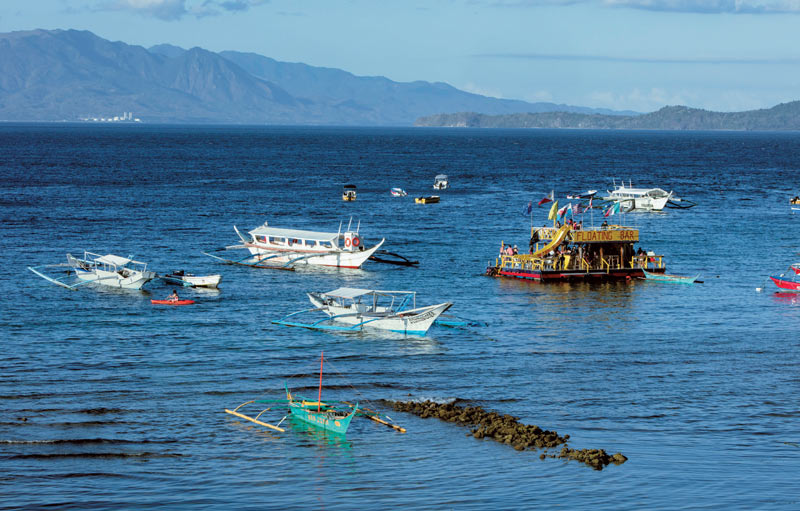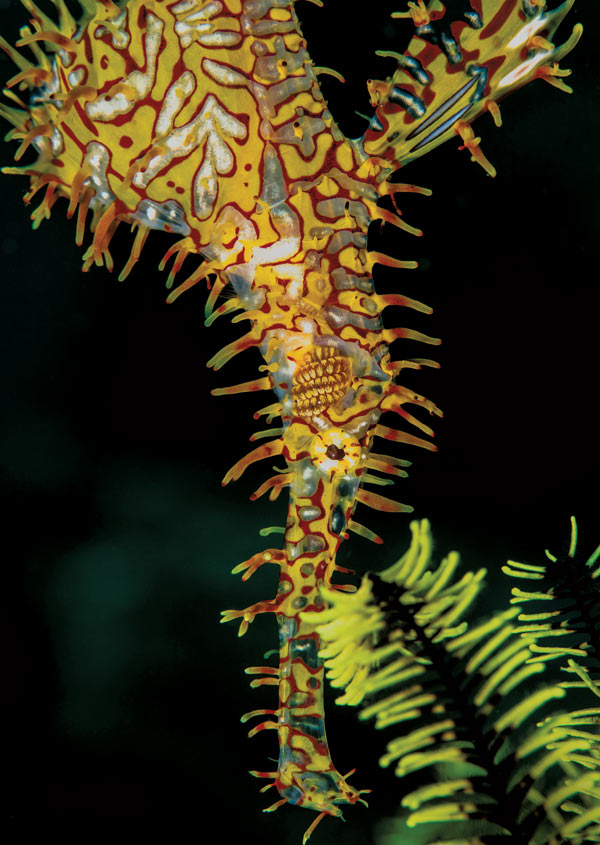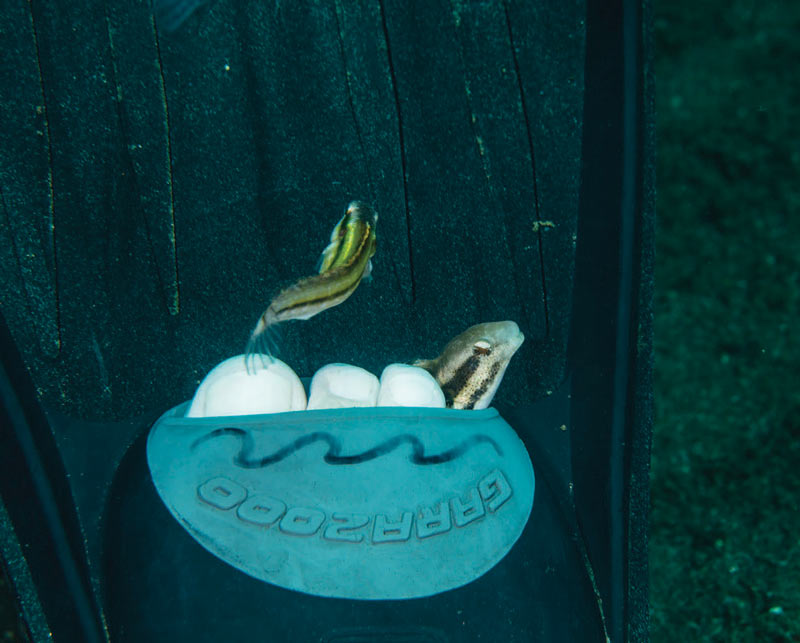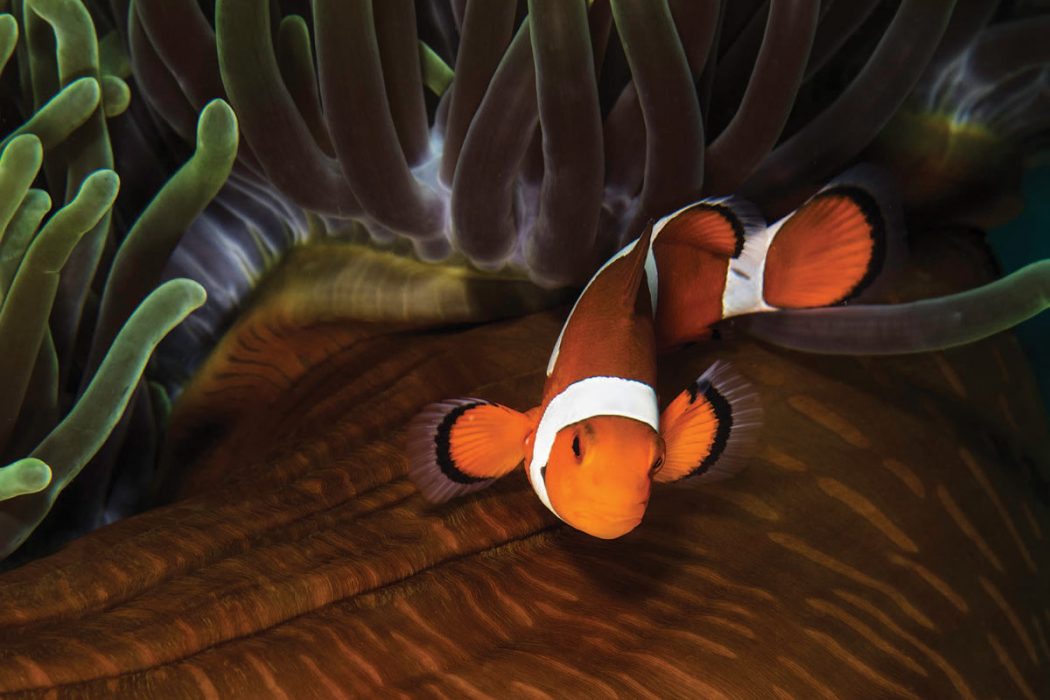THE PHILIPPINES? Yes, we’ve been there. But not entirely. You see, the Philippines consists of more than 7,600 islands in the western Pacific Ocean, spread across over 132,000 square miles (343,000 km2) from north to south. With thousands of tropical islands occupying hundreds of thousands of miles/km, it’s fair to say this place has an uncountable number of coral reefs for adventurous divers to explore. There’s simply no way to visit one area of this vast archipelagic country and say you’ve experienced “the” Philippines. In two weeks’ time spent diving in the Philippines we only got a taste of two islands — Dumaguete and Puerto Galera. We maxed out our bottom time on shallow macro and muck diving in the Philippines and drifted along colorful coral reefs alive with massive schools of fish. We also sampled exotic Filipino-style cuisine and got introduced to the various cultures represented here. We found our first taste of the Philippines delicious. And we’re hungry to return for more.

Both Dumaguete and Puerto Galera are famous for “critter” diving. Just offshore, and in only a few feet/meters of water, you’ll find all sorts of bizarre and beautiful marine life, like this tiny flamboyant cuttlefish.
CATHRYN CASTLE GARCIA PHOTO
A Bit of History
The Philippines is the only country in Southeast Asia that was subjected to Western colonization before it had the opportunity to develop either a centralized government or a dominant culture.
Early Filipinos followed various local religions, a mixture of monotheism and polytheism.
This pattern began to change in the 15th and 16th centuries, when Islam was introduced to Mindanao and the Sulu Archipelago. It was in the midst of this wave of Islamic proselytism that the Spanish arrived, bringing Christianity. Had the Spanish come a century later, Filipinos today might be a predominantly Muslim people.
The Philippines, named after King Philip II of Spain, was a Spanish colony for about 300 years. After its defeat in the Spanish-American War of 1898, Spain ceded the Philippines to the United States in the Treaty of Paris. However, fighting broke out between American forces and Filipino nationalists just days before the treaty was ratified. The ensuing Philippine-American War lasted only three years, but was brutal on both sides, resulting in huge Filipino civilian casualties due to food shortages and disease outbreaks.
American rule in the Philippines during the 20th century eventually switched from colonization to paternalism, with the Jones Act of 1916 promising the nation eventual independence. The archipelago was made semi-independent in 1935, with total independence scheduled for 1945. However, World War II put a wrench in those plans. On December 10, 1941 Japanese troops invaded, quickly capturing Manila. Before the middle of 1942 all of the Philippines were in Japanese hands. American troops recaptured Manila in February, 1945. The Philippines finally became independent on July 4, 1946 although it maintains a close alliance with the United States.
The Philippines has seen its fair share of struggles as a democracy, with recent history that includes rampant political corruption and an unstable economy. Rodrigo Duterte came to power as president in a landslide victory in 2016 after winning over voters with promises of a tough campaign against drugs and political corruption. Although his methods are highly controversial, he is keeping to his campaign promises.
The economy is showing signs of growth, as much as seven percent annually. Tourism is a major contributor to the economy and Filipinos pride themselves in providing professional service. That said, if approached by a “really friendly” Filipino man or woman, keep in mind that the “oldest profession in the world” is practiced in some tourist areas, especially in “go-go” clubs late at night.

Bangkas of all sizes, plus a floating bar, dot the Puerta Galera shoreline.
GUI GARCIA PHOTO
A Philippines Travel Primer
As we mentioned, our two weeks in the Philippines were limited to visiting Dumaguete and Puerto Galera, which we’ll get to in a minute. But in general, when planning a visit you can expect English to be widely spoken. Credit cards are accepted at most major hotels and dive resorts, but exchange some dollars for local pesos (PHP) when you arrive at Manila airport so you’ll have cash for making small purchases. The exchange rate usually hovers around 1 USD to 50 PHP, so your wallet will be fat with colorful local currency.
Don’t even think about renting a car or scooter, because getting around on local roads is chaos. Think NASCAR, circus clowns on unicycles, motorcycle gangs and herds of cats. All sharing the same two lanes. It’s hilarious to watch, but it’d be terrifying to be behind the wheel in traffic. Again, rely on the expert services of a dive travel specialists. They know how to get you from place to place safely, using hired coaches with careful, professional drivers.
Pick pocketing is a thing here, so stay alert. Keep hold of your luggage, purses and backpacks when exiting the airport and touring crowded areas. Violent crime is not a major concern, but use common sense when traveling off the beaten path.
We found the Filipinos we met to be kind and welcoming. Many tend to be a bit shy, but once you start a conversation you can expect lively rapport.
Cellular phone and Internet coverage is good in most populated areas.
The cuisine of the Philippines is truly worth a try. Popular dishes include lechón (whole roasted pig), lonnganisa (local sausage), pancit (stir-fried rice noodles) and kare-kare (stewed meat in a thick peanut sauce). Trust us when we suggest you try the halo-halo, a Filipino dessert with a mixture of shaved ice, ice cream, evaporated milk, boiled sweet beans, fruit and coconut — plus some other stuff. There’s no way to accurately describe how strangely good halo-halo is, so just go for it. Definitely trust us about declining the offer of balut, which is a fertilized duck egg that’s incubated for a few weeks or more (until the embryo has a beak and feathers) and then boiled or steamed. It’s usually served with a beer, but still.
If you’re not an adventuresome eater, don’t fret. American-style fare is easy to find.

A ghost pipefish attempts to blend in with a crinoid.
CATHRYN CASTLE GARCIA PHOTO
Diving in the Philippines
We found the diving operations to be amongst the best we’ve encountered anywhere. You’ll find live-aboards and full-service dive resorts that operate day boats running several trips a day. Most boats are variations of the traditional two- or three-hull bangka, which is Filipino for “boat.” A giant stride entry from a platform is the norm, although some larger boats also have drop-down ladders. On smaller boats, a backward roll entry might be used. No matter what entry and exit is used, when diving in the Philippines you’ll find the boats all have ample crewmembers eager to assist you in and out of the water. They know how to handle expensive camera gear, too. The divemasters are hands-down some of the best we’ve ever encountered.
Water temperatures are tropical, ranging from 75 to 82 degrees Fahrenheit (24 to 28 Celsius). A light wet suit and tropical hood is recommended when diving in the Philippines, especially for long bottom times in shallower “critter” diving spots.
The resorts catering to divers have dedicated gear rinse/storage areas and camera rooms. Crewmembers do all the heavy lifting, so all you need to do is show up to the boat on time and double check to see that your gear has been loaded. While we tend to favor live-aboards, this type of service easily changes our minds.
Nitrox is readily available in many locations. Ditto for scuba training — and many resorts and live-aboards have dedicated photo pros on staff.
Tipping is a relatively new practice in the Philippines. Most dive resorts have a policy in place to aid you in rewarding exceptional service, so ask your travel planner or resort manager.

You know you’re racking up a lot of bottom time on shallow “critter” sites when the blennies start making a home inside your fin.
CATHRYN CASTLE GARCIA PHOTO
Diving in the Philippines: Dumaguete
Dumaguete is a coastal region on the southeast side of Negros, adjacent to Cebu. It’s the third largest island in the Philippines, about an hour-long flight south from Manila. Daily flights from Manila are available. Most dive specialists are happy to arrange your domestic flights, which makes it relatively easy to explore more than one location during your Philippines visit. Ask your local dive center or dive travel expert about this service.
Diving is done within the protected waters of the Dauin Marine Sanctuaries. Dauin (pronounced Da-win) is known for its extraordinary marine biodiversity. The marine creatures here must have gotten the memo about their protected status, because there’s no shortage of amazing marine life to be found. The beaches here aren’t the “blinding white” you see pictured on postcards of the tropics. Nope, they’re better than that. Better, at least for divers — and sea creatures — because the brownish hues of the seafloor make it easy for bottom-dwellers like frogfish and cuttlefish to blend in. We spotted all sorts of bizarre and beautiful creatures just offshore, at our resort’s “house” reef — in only 10 feet (3.3 m) of water. Dumaguete is a “critter” diver’s macro paradise, although several sites feature large corals and schools of jacks and groupers that will delight wide-angle shooters. On several dives, we racked up two hours of bottom time, squinting at tiny squids and marveling at pouty-faced seahorses camouflaging themselves in the seagrass beds. We didn’t move more than a short distance from our original starting point on the house reef. It was that good! One afternoon we spent so much time in one spot, taking in the target-rich environment that a pair of blennies actually started to “nest” in the foot pocket of Cathryn’s fin. She felt a “tickling sensation,” only to look down to notice a tiny fish wriggling between her toes! In more than three decades of diving, it was a first.
A day trip to Apo Island is a must-do when visiting Dumaguete. The dive sites are part of a marine habitat reserve protected by the National Integrated Protected Area (NIPA) Act. You’ll find amazing diversity of gigantic hard corals, mixed with some soft corals, too. And sea turtles? We stopped counting.
Another trip many ocean enthusiasts often make from Dumaguete is to Oslob, Cebu, to snorkel with whale sharks. In 2011, local fishermen began feeding young whale sharks. Now dozens of whale sharks congregate just offshore on a regular basis. It’s available only as a guided tour and scuba is not allowed. If you go, expect crowds.
October through June is considered the main season for diving in the Philippines. July to September is considered monsoon season. Many divers combine Dumaguete with a trip to Puerto Galera, Moalboal, Anilao or Malapascua, which is known for thresher sharks.

Verde Island’s dive sites are “on fire” with color.
GUI GARCIA PHOTO
Diving in the Philippines: Puerto Galera
Puerto Galera is situated on the north tip of Mindoro Island across the Isla Verde Island passage, about 81 miles (130 km) south of Manila. You’ll likely reach Puerto Galera by boat from the port of Batangas, after a few hours’ drive from Manila. Once again, put the travel details in the hands of experts and you’ll find it easy to get around.
Once you arrive and stick your head underwater you’ll know it’s worth it. Puerto Galera is a diver’s version of heaven, with a wide range of dive sites within a short boat trip from Sabang Beach. You’ll find shallow sites with amazing macro subjects like nudibranchs and rhinopias, along with thriving coral reefs and wrecks and deep drop-offs. Tech divers love Puerto Galera, as mixed gas, rebreathers and tech trips are readily available.
The area was declared a United Nations Educational, Scientific and Cultural Organization (UNESCO) Man and Biosphere Reserve back in 1973. The area once relied on fishing. Now, tourism is king.
Clam City is a shallow site named for its abundance of large tridacna clams. Another favorite site is the wreck of the Alma Jane, which is about a one-minute boat ride from Sabang Beach. Despite its proximity to shore, it’s home to all sorts of fascinating marine life, including sea turtles, snappers and schools of spotted sweetlips. The frogfish we saw here appeared to be on steroids.
Some sites off Puerto Galera are for slow cruising, while others are high-adrenaline drifts with ripping currents. Make sure you pay close attention to the divemasters’ briefings if you are scheduled for some advanced sites.
A day trip across the straights to Verde Island is a must-do. Here you’ll find shallow and deep sites adorned with colorful coral reef and plenty of big stuff — sharks, rays, schooling trevallies — cruising the blue. Some sites are clouded in anthias that glisten like jewels in the current. The Verde Island Wall is considered to be one of the best sites for diving in the Philippines.
The Philippines is vast, diverse and more dedicated to the traveling diver than ever before. Marine preserves are now widely established and modern, full-service dive resorts and live-aboards are the norm rather than the exception when diving in the Philippines. And with English widely spoken, communication isn’t a challenge. The chaos we experienced is a happy, friendly sort of chaos. Our first trip diving in the Philippines was richly rewarding. It definitely has us ready for more Philippines adventures.
The authors wish to thank Atlantis Philippines Dive Resorts for their assistance with this article.
Story and photos by Cathryn Castle Garcia and Gui Garcia






